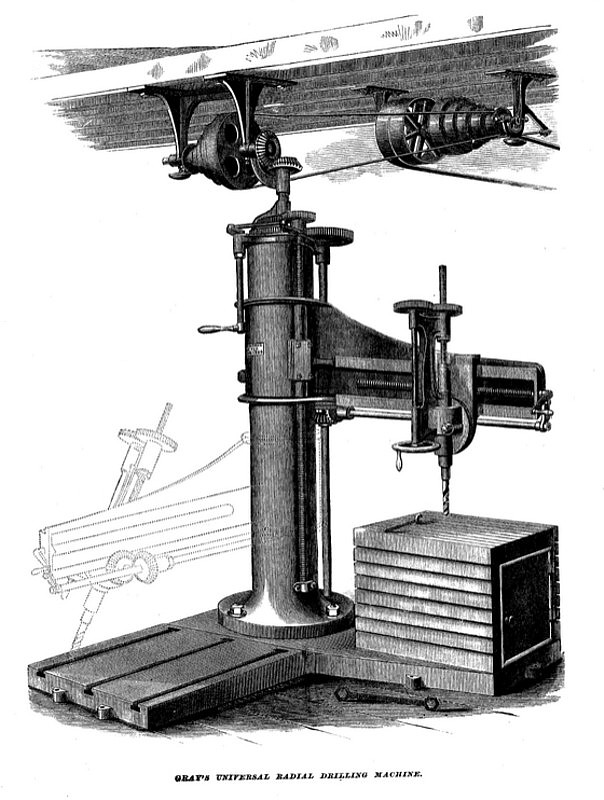|
Title: |
1873 Article-Niles Tool Works, Gray's Radial Drilling Machine |
|
Source: |
The Manufacturer and Builder, V5 #9, Sept 1873, pgs.198-199 |
|
Insert Date: |
12/20/2014 7:21:17 PM |
We will new describe one of the finest and most useful of their productions—the Universal Radial Drilling Machine—of which we give a fine representation on the opposite page, and the general form and details are made according to Gray’s patent. It is seen that the machine swings around a stationary sleeve, bearing well up in the interior of the column; the column itself is turned over, and the arm, which is fitted snugly to it, is raised or lowered by power. The driving is applied through the center direct, (avoiding any difficulty in the complete revolution of the machine,) and transmitted to the upright shaft, whence the horizontal shaft carries it to the spindle by means of two pairs of mitered gears, The head is moved to its position upon the arm by means of the horizontal screw. The drill can be used vertically, horizontally, or at any required angle The combination of the swing of the entire machine, the raising or lowering of the arm, together with the complete swiveling capacity of the spindle, renders it comparatively easy to drill a hole in any irregular and unwieldy piece of work, without the necessity of moving it after it is brought within the swing of the machine. The table is used for convenience when operating upon small work.
The column is 8 feet high, turned true and parallel. When the arm is raised to the top of the column, the distance between the planed and T-slotted base plate and the end of the drill spindle is 5 feet 7 inches, admitting work nearly that height under the drill. The distance from the column to the drill spindle (in vertical position) is 4 feet 6 inches, consequently a hole can be drilled in the center of a circle 108 inches in diameter, a reach beyond that of almost any ordinary drill press. The spindle is made of steel, and is 2 3/8 inches in diameter. It has the necessary traverse for deep holes. When the ends of very long work (such as the flanges of pipe) are to be drilled, the arm can be lowered to within a few inches of the floor or bed-plate, and the drill-spindle pointed in a horizontal line; there is therefore scarcely any limit to the length of the work that can be drilled.
The driving power is very great and fully equal to any requirement. The cones are large in diameter, and have five changes of speed for wide bolts; there in also an increase of power gained through the series of gearing leading to the spindle, more than equivalent to the usual back gearing. The large size new pattern Radial Drilling Machine will drill at any point within a circle of 12 feet diameter, as the whole machine sweeps around such a circle. Its construction renders any point within reach of the machine available, so that the work to be done need not be moved when once set. The size of solo plate in this style of machine is 7 x 7 feet, with T-slots for bolting down; it has a square table, 30 inches square and 26 inches high, planed and T-slotted, which also forms a closet to hold tools The pulleys on the counter-shaft are 15 inches in diameter and 4½ inches face; they run 200 revolutions per minute. The cones are large, and have changes for wide belts. It is back-geared 80 to 1 of spindle, and powerful enough to bore 12-inch holes, while it weighs about 9,000 pounds.
US Patent: 97,908 |
|
 1873 Niles Tool Works, Gray's Radial Drilling Machine
1873 Niles Tool Works, Gray's Radial Drilling Machine
|
|